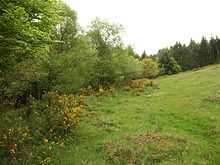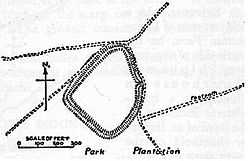Plainsfield Camp
| Plainsfield Camp | |
|---|---|
|
Plan of earthworks at Plainsfield Camp, Park Plantation | |
| Location | Aisholt in Somerset, England |
| Coordinates | 51°07′11″N 3°10′12″W / 51.11972°N 3.17000°WCoordinates: 51°07′11″N 3°10′12″W / 51.11972°N 3.17000°W |
| Area | 0.9 hectares (2.2 acres) |
| Built | Iron Age |
| Reference no. | 189501[1] |
 Location of Plainsfield Camp in Somerset | |
Plainsfield Camp (or Park Plantation or Cockercombe Castle) is a possible Iron Age earthwork on the Quantock Hills near Aisholt in Somerset, England.[2]
The so-called hill fort has several features that make it more likely to be an animal enclosure, than a defended settlement:
- single rampart with ditch
- simple opening for an entrance
- situated on the slope of a hill
- the hill rises over 50 m above the ring
- the area is only 0.9 hectares (2.2 acres)
The case for an enclosure is less clear cut than for Trendle Ring, since Plainsfield is on a spur and does have steep slopes on two sides, making it like a promontory fort, similar to nearby Ruborough.
It is a Scheduled Ancient Monument.[3]
Background

Hill forts developed in the Late Bronze and Early Iron Age, roughly the start of the first millennium BC.[4] The reason for their emergence in Britain, and their purpose, has been a subject of debate. It has been argued that they could have been military sites constructed in response to invasion from continental Europe, sites built by invaders, or a military reaction to social tensions caused by an increasing population and consequent pressure on agriculture. The dominant view since the 1960s has been that the increasing use of iron led to social changes in Britain. Deposits of iron ore were located in different places to the tin and copper ore necessary to make bronze, and as a result trading patterns shifted and the old elites lost their economic and social status. Power passed into the hands of a new group of people.[5] Archaeologist Barry Cunliffe believes that population increase still played a role and has stated "[the forts] provided defensive possibilities for the community at those times when the stress [of an increasing population] burst out into open warfare. But I wouldn't see them as having been built because there was a state of war. They would be functional as defensive strongholds when there were tensions and undoubtedly some of them were attacked and destroyed, but this was not the only, or even the most significant, factor in their construction".[6]
See also
References
- ↑ "Plainsfield Camp". National Monuments Record. English Heritage. Retrieved 26 March 2011.
- ↑ "Plainsfield Camp slight univallate hillfort". National Heritage List for England. English Heritage. Retrieved 24 August 2014.
- ↑ "Plainsfield Camp Hillfort.". Digital Digging. Retrieved 27 August 2010.
- ↑ Payne, Andrew; Corney, Mark; Cunliffe, Barry (2007), The Wessex Hillforts Project: Extensive Survey of Hillfort Interiors in Central Southern England, English Heritage, p. 1, ISBN 978-1-873592-85-4
- ↑ Sharples, Niall M (1991), English Heritage Book of Maiden Castle, London: B. T. Batsford, pp. 71–72, ISBN 0-7134-6083-0
- ↑ Time Team: Swords, skulls and strongholds, Channel 4, 2008-05-19, retrieved 16 September 2009
- A Field Guide to Somerset Archaeology, Lesley and Roy Adkins (1992) ISBN 0-946159-94-7
- The Archaeology of Somerset, Michael Aston and Ian Burrow (Eds) (1982) ISBN 0-86183-028-8
